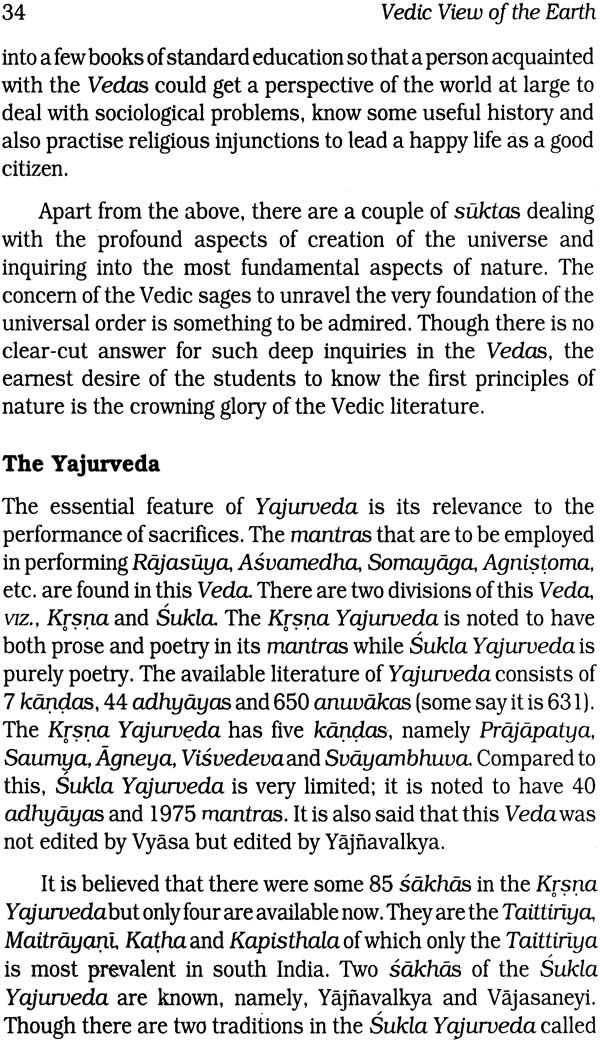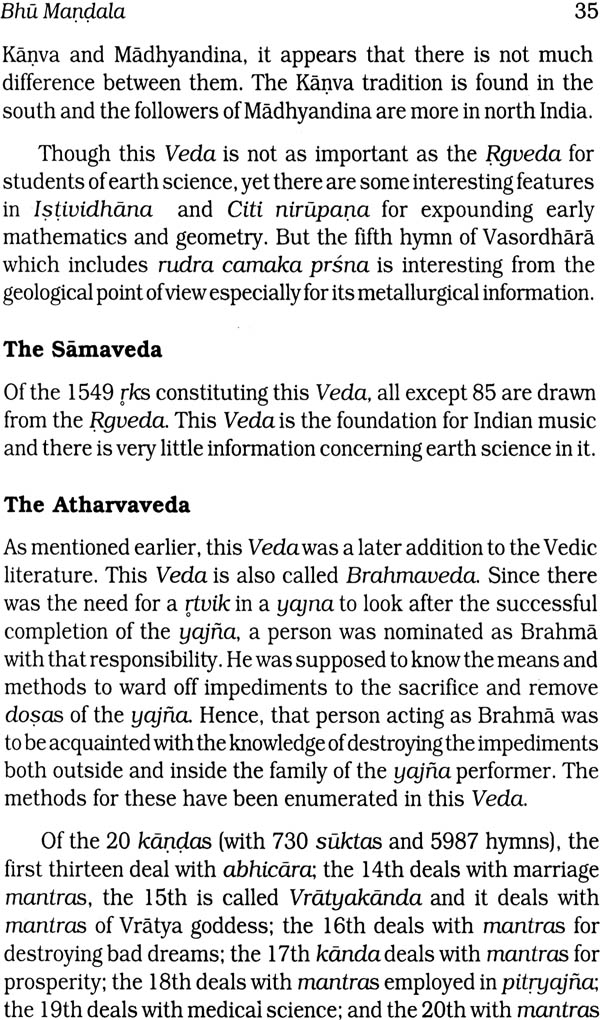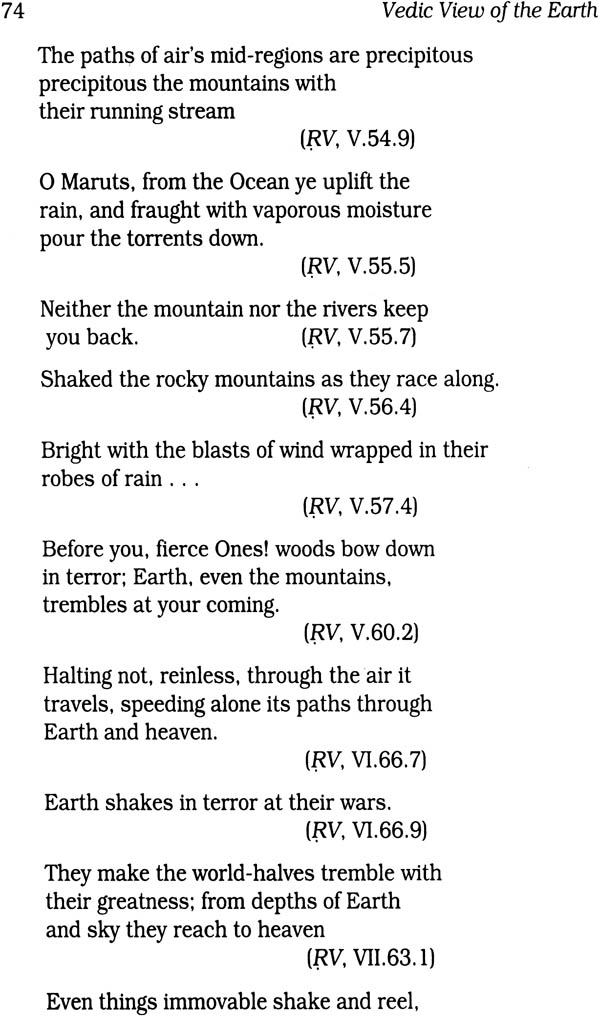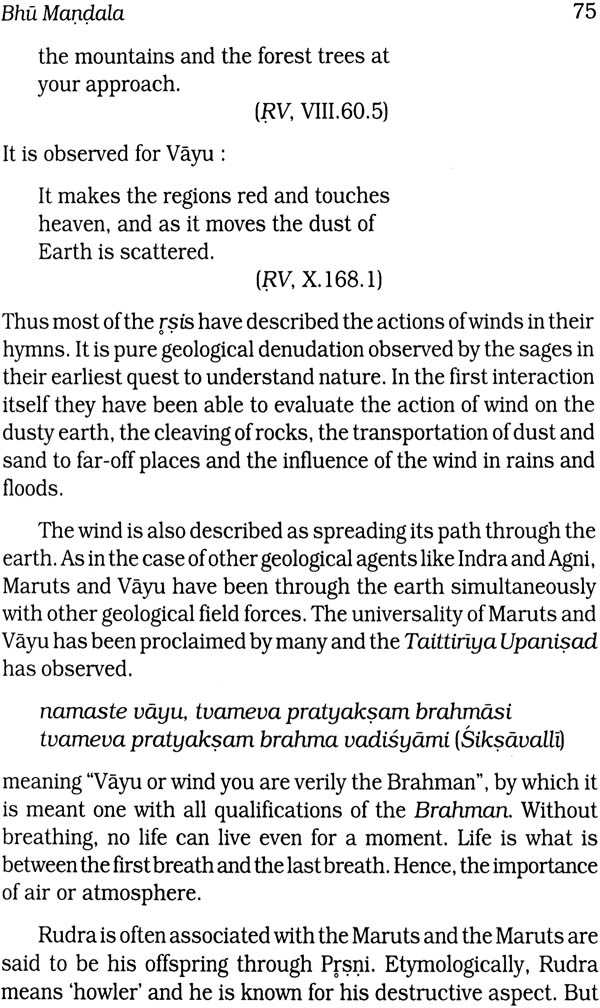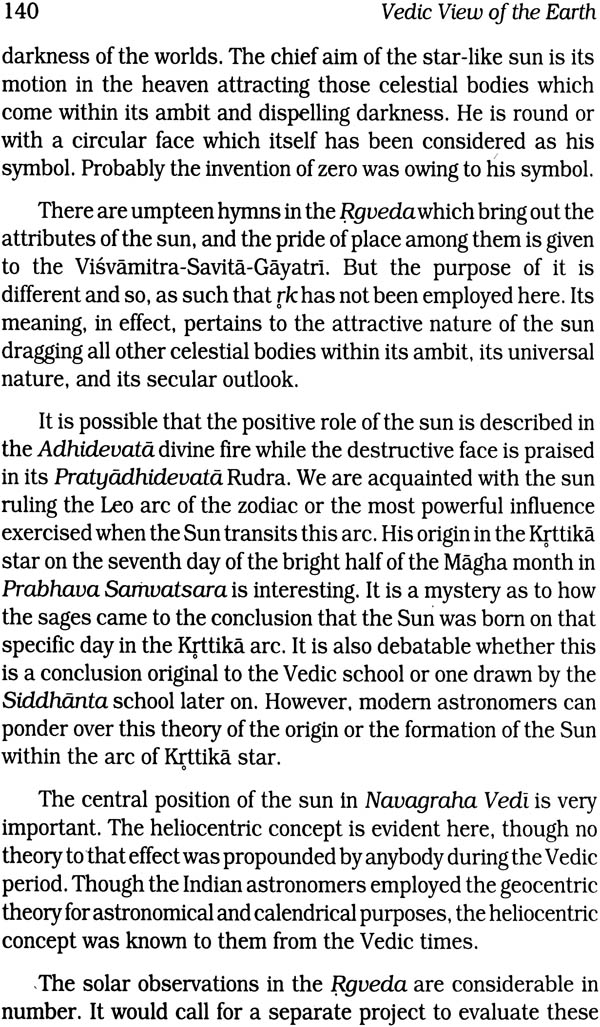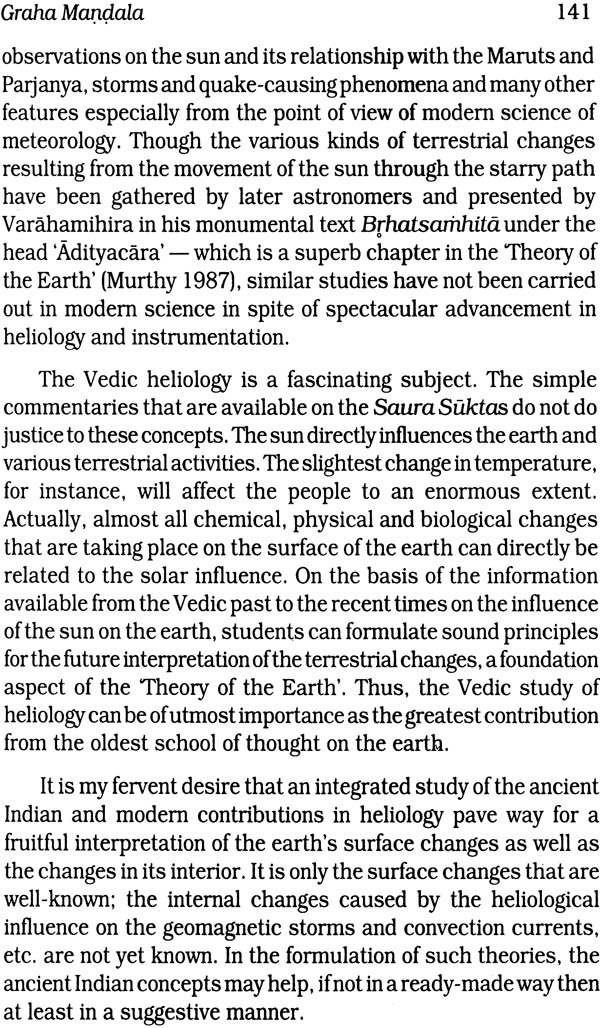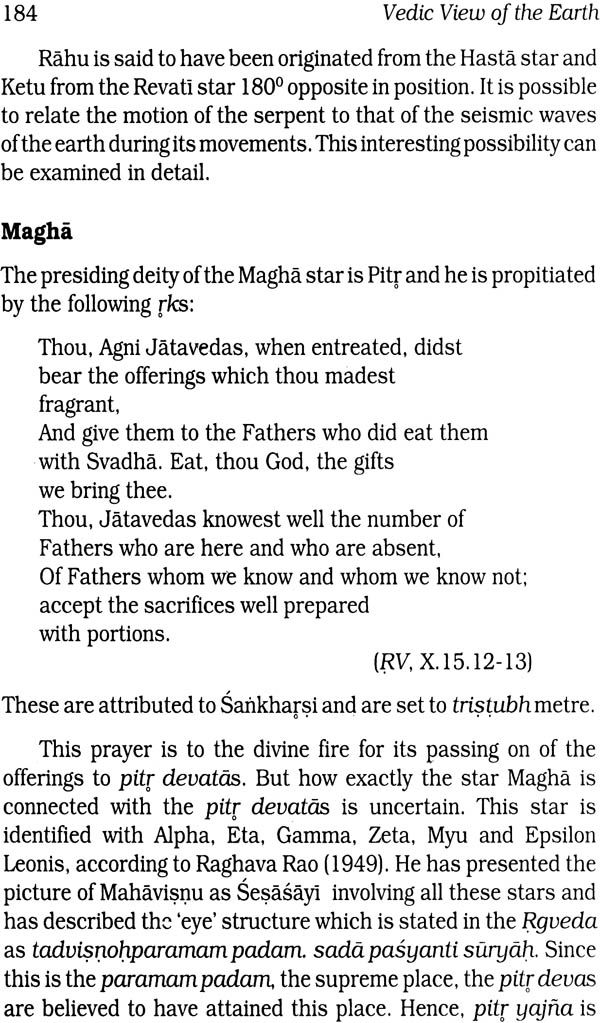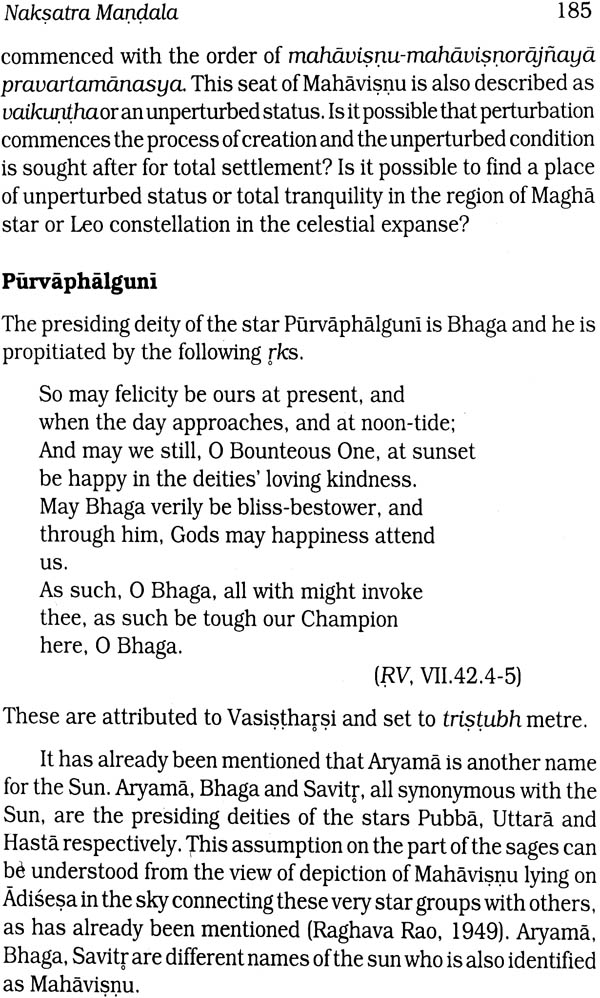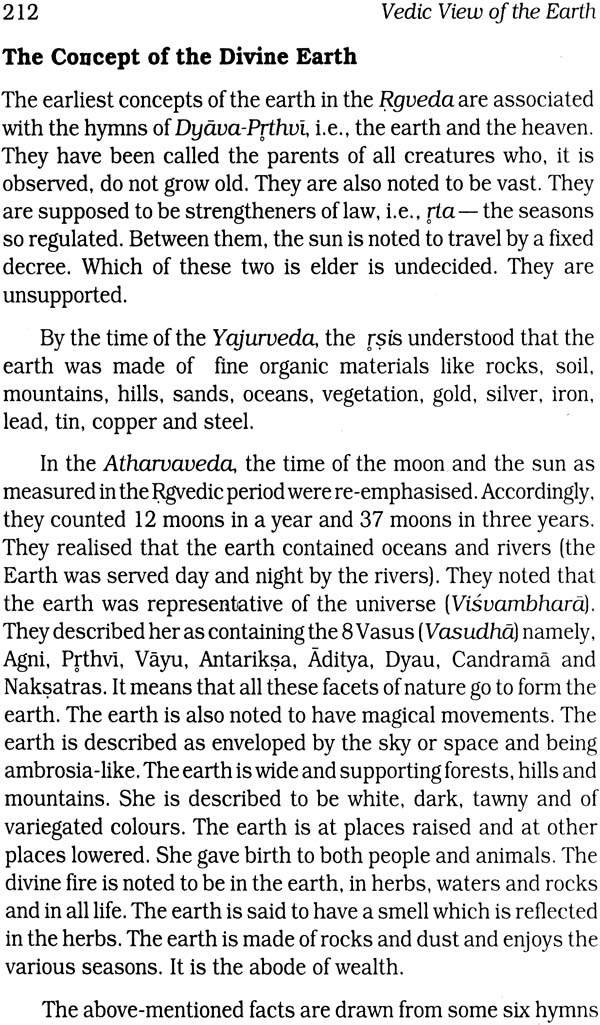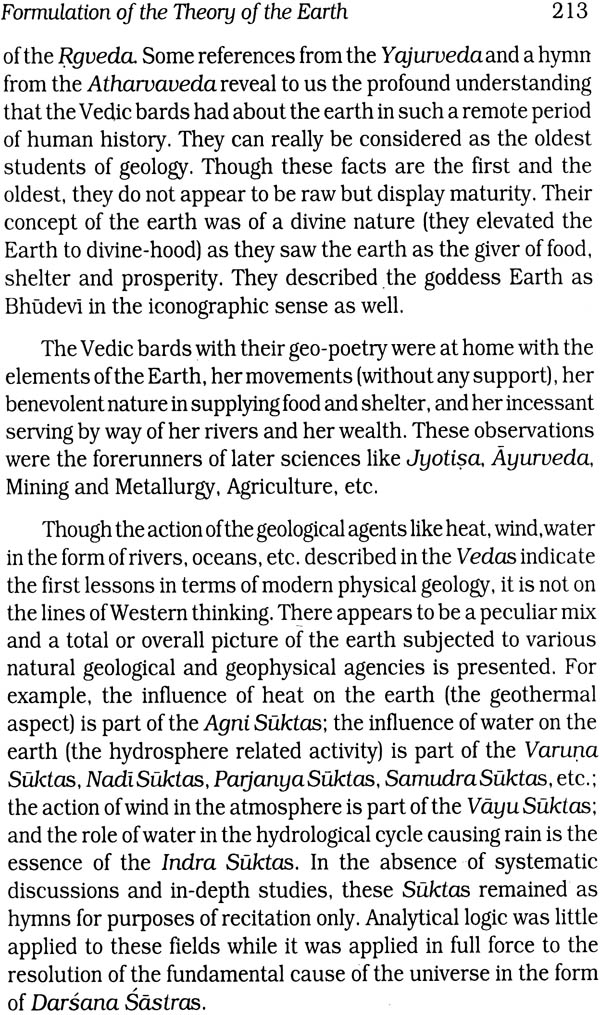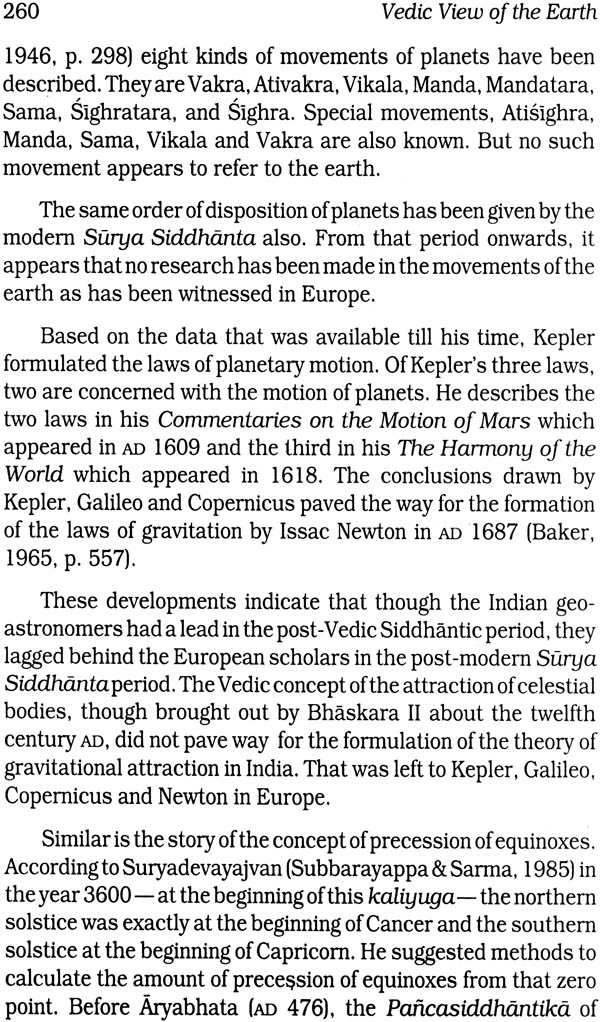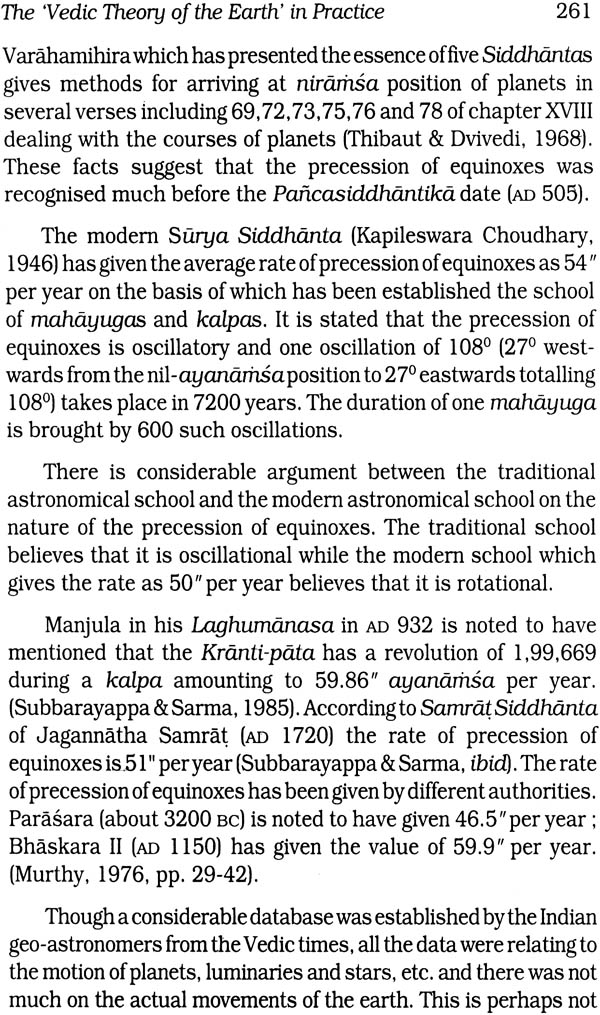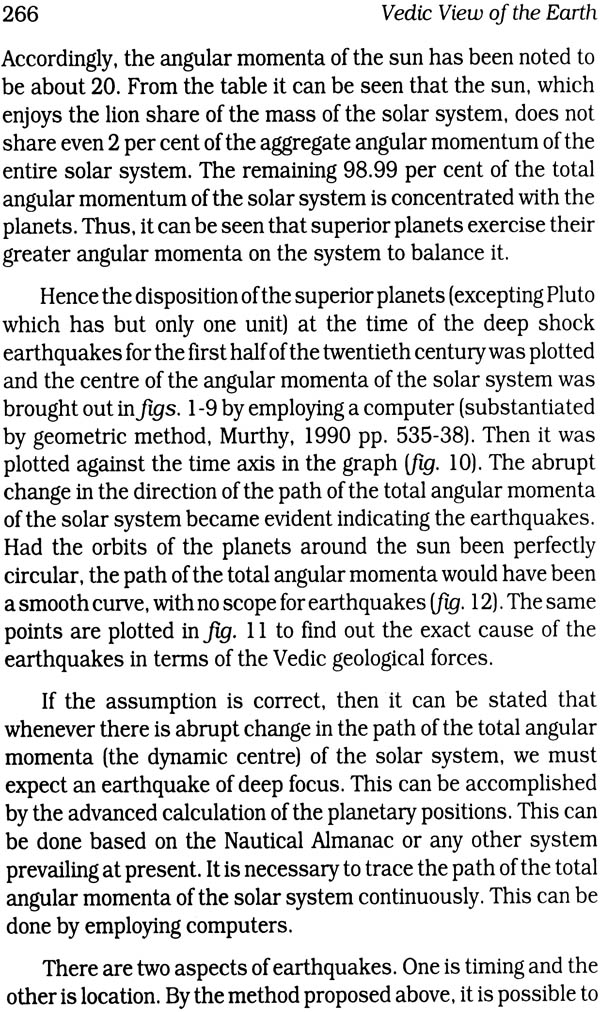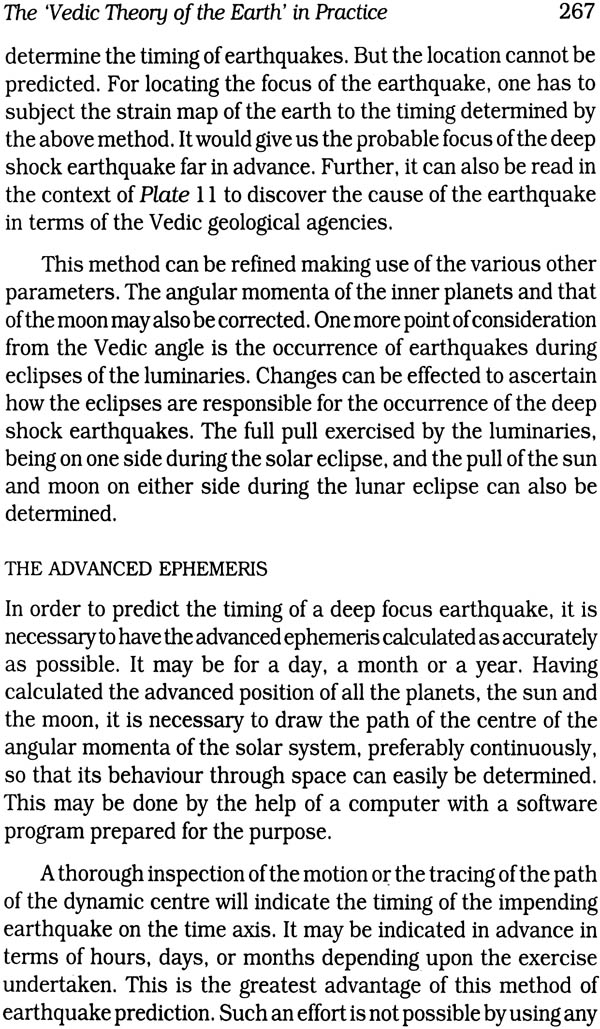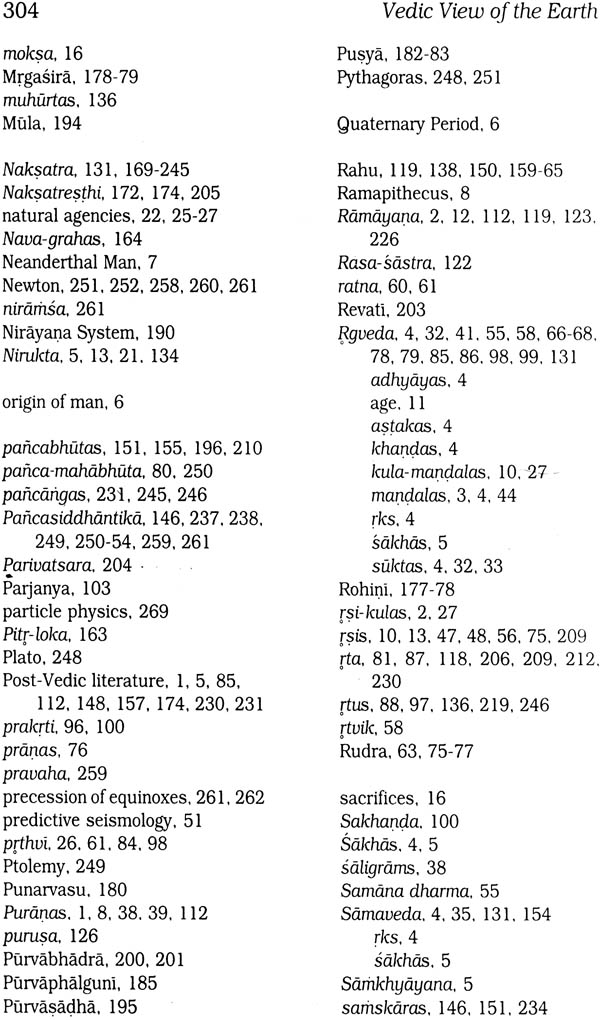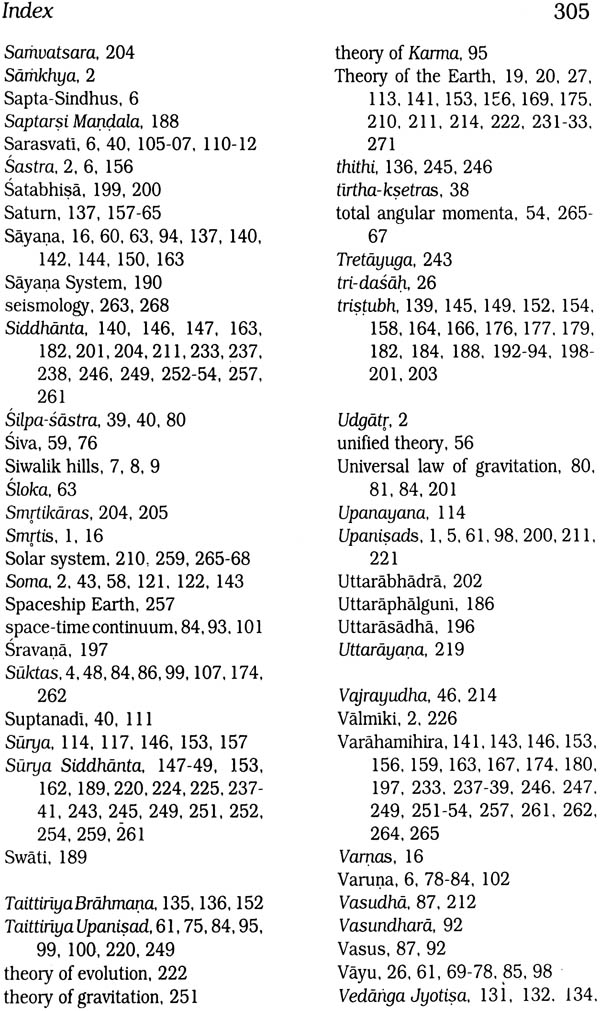
Vedic View of the Earth (A Geological Insight Into The Vedas)
Book Specification
| Item Code: | NAD882 |
| Author: | S. R. N. Murthy |
| Publisher: | D. K. Printworld Pvt. Ltd. |
| Language: | English |
| Edition: | 2013 |
| ISBN: | 9788124600917 |
| Pages: | 328 |
| Cover: | Hardcover |
| Other Details | 9.0 inch X 5.5 inch |
| Weight | 550 gm |
Book Description
Vedas are indisputably the oldest of mankind’s documents. Which not just magnificently articulate the early civilized man’s wonderment about the cosmos and his yearnings for the divine, but also unfold the foundations of many ancient sciences, like mathematics, astronomy, alchemy, metallurgy, botany and medicine. This book, however, is the first ever effort to show how Vedas embody the earliest discourses on the earth and the erth-related phenomena.
Combining in him the acumen of a professional earth scientist and a highly proficient Sanskrit, Dr. Murthy marshals the whole extent of geological data form the Vedic/post-Vedic literatures, and even some of the later works, like Varahmihira’s Brahatsamhita (of the 5th century AD)—in his thematic effort to highlight the Vedic worldview of the earth and, importantly, how it almost approximates the projections of modern earth science.
Developed form over three decades of Dr. Murthy’s researches in ancient Sanskrit literature, the study employs contemporary scientific idiom to describe Vedic perception, of the earth, its origin, shape, dimensions, constitution, movements, quakes/tremors, and its position vis-à-vis the solar system, starts and ethereal space. Also including, heliocentricity, the book puts forth the Vedabased methods for deciphering/predicting deep-focus earthquakes – for future research and investigation.
Together with a glossary of Sanskrit terms and relevant bibliographic references, this geological perspective on the Vedas will fascinate scholars, specialists and discerning readers alike.
S.R.N. Murthy, Ph. D, F.G.S (Indology), is a professionally trained earthscientist and Sanskrit Scholar, whose research concerns have, for over three decades, focused on the revival of ancient Indian sciences concepts: in modern scientific language. And, resultantly, has produces books, like the Integrated Theory of the Earth and Geophilosophical Aspects of the Rgveda; besides Ancient Indian Theories of the Earth, comprising a series of the lecture delivered at the CVentre of Advanced Studies in Sanskrit, University of Poona, Pune.
Dr. Murthy retired as Director form the Geological Survey of India.
After going through the book The Earth by H. Jeffrys (Cambridge, 1924)1 was, as a student of earth science, interested in bringing out a book on the same subject incorporating thoughts from the Vedic heritage of India. But the work was postponed for many reasons. During the period of my service as a scientist of the federal Geological Survey, the Survey, appreciating my efforts, sponsored me for the Third International Sanskrit Conference held at Paris in 1977 for• presenting the following papers — (I) The Vedic Theory of the Earth, (ii) Varahamihira’s Contribution to the Vedic Theory of the Earth, and (iii) An Integrated Theory of the Earth. The proceedings of the Conference, however, published only one paper, i.e., “Varãhamihira’s Contribution to the Vedic Theory of the Earth”. Later, the Bangalore-based Kalpataru Research Academy published all the three papers in the form of a book titled An Integrated Theory of the Earth (Murthy, 1987) which contains the rudiments of a Vedic theory of the earth.
In the year 1992, Professor V.N. Jha, Director, Centre of Advanced Study in Sanskrit, University of Poona, invited me to give a series of ten lectures on “Ancient Indian Theories of the Earth”, which were later published (Murthy, 1992). These books, however, could not bring out the essentials of earth sciences in detail as culled from Sanskrit literature.
My endeavour here has been to present all data relating to earth sciences in the Vedas for determining the veracity of a Vedic theory of the Earth. The material had been with me for a long time but I was waiting for a suitable opportunity. It finally came when Shri Kireet Joshi, the then Member-Secretary, Rashtriya Veda Vidya Pratishthan, New Delhi evinced great interest in the subject. The present endeavour is a consequence of that. The material presented in this book has been culled by me over a period of three-to-four decades, Here, I present my researches to the modern students of the earth science as well as students of Sanskrit specialized in the Bhü..ãstras (for sästra means science in Sanskrit).
Since the appearance of the book The Principles of Geology by Lyell in 1830, when the modern discipline of geology took shape as a science, much geological information has been accumulated. The latter half of the present century, in particular, has seen an unprecedented collection of geologic information. Similarly, mining activity and other aspects of geology have also developed manifold. When examining such a vast literature pertaining to geology, one wonders whether such information might have existed in the Orient, since almost all the information that can be called modern are occidental. Actually, the way the oriental people, especially the Indians, treated the earth and exploited earth material for advancement of human civilization, geo-philosophy, etc. has not been dealt with by any book in a comprehensive manner. In this context, though this book alone may not fill the gap of information, it is an effort to help modern students appreciate the eastern views as compared to the Western views.
It is well-known that the Middle East, the Indus and the Chinese people developed the most ancient civilizations (Lockyer, N.J., 1964, The Dawn of Astronomy, Massachusetts Institute of Technology, p. 432). Lockyer states, “I have already remarked that the ideas of the early Indian Civilization, crystallized in their sacred book called Vedas, were known to us long before either the Egyptian or Babylonian and Assyrian records had been deciphered. Enough, however, is now known to show that we may take the Vedic’s to bring before us the remnants of the first ideas which dawned upon the minds of the earliest dwellers in Western Asia— that is, the territory comprised between the Mediterranean, the Black Sea, the Caucasus, the Caspian Sea, the Indus, and the waters which bound the southern coasts — say, as far as Cape Comorian.” Further, he observes, ‘But the Vedas speak funny, while as yet information on this special point is relatively sparse from the other regions. It is wise, therefore, to begin with India, whence the first complete revelations of this kind came. Max Muller and others during recent years have brought before us an immense amount of most interesting information, of the highest importance for our present subject”. He continues, “They tell us that in 1,500 BC there was a ritual, a set of hymns called Veda (Veda meaning ‘knowledge’). These hymns were written in Sanskrit, which few years ago was almost ai unknown language; we know now that it turns out to be the nearest relation to our English tongue. The thoughts and feelings expressed in these early hymns contain the first roots and germs of that intellectual growth which connects our own generation with the ancestors of the Aryan race. Those very people who, as we now learn from the Vedas, at the rising and the setting of the Sun, listened with trembling hearts to the sacred songs chanted by their priests. The Veda, in fact, is the oldest book in which we can study the first beginnings of our language and of everything which is embodied in all the languages under the Sun. The oldest, most primitive, most simple form of Aryan Nature-worship finds expression in this wonderful hymnal, which doubtless brings before us rituals of the ancient Aryan populations represented also by the Medes and Persians.” This royal astronomer of England should have lived to see the later developments in Indology when it was recognized that the Vedas are first texts in the library of mankind. Lockyer is believed to be the founder of the Nature magazine.
The Vedic foundations of the ‘cultural heritage’ of India have received tremendous appreciation through the ages. But the Vedic foundations of the ‘scientific heritage’ of India are hardly known. All the post-Vedic literature including the Brãhrnartas, Arartyakas, Upanisacis, Daráanas, Purãrto.s, Smrtis and even Kavyas emphasise man’s spiritual development alone. Even the commentaries that are available on the Vedas focus on the spiritual aspect of the Vedas only. It appears that there were as many as sixteen commentaries on the Vedas by the time of Yaskacarya, none of which are available to us today apart from the commentary of Yãska and later that of Madhva-Sayaia.carya in the thirteenth century iui Madhva-Sãyanãcarya’s commentary is the standard one and referred to by one and all. Even this focuses on the spiritual aspects of the Vedas. It is understood, perhaps rightly to a large extent, that the Vedas form the foundations of spiritual thought in India. Though the recent commentaries on the Vedas by Aurobindo and Maharsi Dayananda Sarasvati give an impression of a scientific temper in the Vedas, these mostly emphasize their spiritual and symbolic views and not their scientific value. As a result, the world knows the Vedic’s to be a compendium of religious and spiritual spells only. What emerges is a most disturbing situation arising, one may say, out of a kind of bias on the development of post-Vedic literature of India. But getting down to the problem itself, what Physics, Chemistry or Biology can be deciphered in the Vedic’s? Can there be anything of modern science in the Vedas? What kind of literature is contained in the Vedic’s which would help in propounding of scientific thoughts? Why is the scientific value of these texts not brought out for the appreciation of modern scientists?
The Sanskrit term sastras mean sciences’. Almost all of the cstras known in Sanskrit literature owe their origin to the Vedas, like jyotisa, sãmkhya, rasa, dharrna or religion, etc. The term, dharma or religion has been suffixed to astra to give the former a scientific outlook. Valmiki in his Ramayana mentions that amnayartãm ayogena .astrampraithi1am Siva meaning, without the application of the Vedas, the scientific disciplines become degenerated and obsolete. Hence, any Sãstra had to have the foundation of the Veda especially for its sustenance and development. This being the case, why is it that the Vedas are clearly partial towards religion and spiritualism? Millions of people over thousands of years have been made to believe in the religious and spiritual aspects of the Vedas with the result that inquiry into the Vedic sciences has taken a back seat, even totally forgotten.
The Vedas were plenty during the pre-Vyasa period as per the dictum anantã vai veclãh, meaning that the Vedas are endless. Whether, at this time, the Vedic statements were employed only for performing sacrifices is uncertain. But during the post-Vyasa time, it is certain that the Vedic literature, having been edited by him, was employed essentially for performance of sacrifices. Vyasa is credited with having edited the then available Vedas into Rg, Yajur and Sãma sections so as to help the hott, adhvaryu and udgatpriests in sacrifices. Later restriction was laid down on growth of the Vedas and the Vedas edited byVyasa, which is what is available to us today, gained currency.
In the pre-Vyasa period, the Vedic compositions were made by the si-ku1as after considerable observation and they were codified in the form of hymns. On discovering changes or shortcomings, they composed new hymns and called the old ones perhaps khila or invalid. The observations made by them were put in the kula mandalas of the Rgveda. The books of the Rgveda along with the names of sages they are attributed to are given below:
These books of the Rgveda were a result of continuous and unstinted efforts of dynasties of sages over several centuries especially with regard to various observations of nature around them. The hymns of the eighth mcutda1a are mostly attributed to the dynasty of Kanva and the hymns of the ninth muiç1a1ato Somapavamana. The first and the tenth rnandalas are known to be of later origin.
The original extent of the Vedas is not available to us today. That which is available to us now, it appears, is a small fraction of the extensive Vedic literature that was available in the pre-Vyasa period.
| Preface. | VII | |
| Acknowledgements | XXIII | |
| Abbreviations | XXV | |
| Plate : Stellar arcs of the formation of luminaries, planets and nodes | XXVI | |
| Introduction | 1-27 | |
| The Vedic Literature | ||
| The Vedic Sakhas | ||
| Origin and Development of the Vedic Literature | ||
| Age of the Rgveda | ||
| Authors of the Vedas | ||
| Commentaries on the Vedas | ||
| Ambiguity of Vedic Definitions Scope of the Work | ||
| Part I:Theoretical Observations | ||
| 1 | Bhu Maidala | 31 - 112 |
| Subject-Matter of the Vedic Literature | ||
| The Rgveda | ||
| The Yajurveda | ||
| The Samaveda | ||
| The Athavaveda | ||
| Geological Aspects of Hindu Religion | ||
| Indra | ||
| Agni | ||
| Agni and the Geothermal Field | ||
| Maruts and Vayu | ||
| Varuna | ||
| Rgvedic Concept of Vamiia | ||
| Dyvaprthvi and Bhümi | ||
| The Earth in the Rgveda | ||
| The Earth in the Atharvaveda | ||
| The Earth in the Yajurueda | ||
| The Earth is called Vasundharä’ | ||
| Antariksa | ||
| Apa | ||
| Paijanya | ||
| Rivers | ||
| Sea Waters | ||
| 2 | Graha Mandala | 113- 167 |
| The Grahas | ||
| Savitr, Aditya, Pusan, Viiu | ||
| Soma | ||
| The Rgvedic Soma | ||
| Role of the Luminaries in the Vedic Calendar | ||
| Pancagrahas | ||
| Graha-Yajfla | ||
| Prakäaka Grahas | ||
| The Sun | ||
| The Moon | ||
| Mars | ||
| Mercury | ||
| Jupiter | ||
| Venus | ||
| Saturn | ||
| Aprakãaka Grahas | ||
| Rahu | ||
| Ketu | ||
| 3 | Nakatra Mandala | 169 - 206 |
| Avini | ||
| Bharani | ||
| Krttika | ||
| Rohni | ||
| Mgaira | ||
| Ardra | ||
| Punarvasu | ||
| Puya | ||
| Alesa | ||
| Magha | ||
| Purvaphalguni | ||
| Uttaraphalguni | ||
| Hastã | ||
| Citra | ||
| Swãti | ||
| Visãkha | ||
| Anurãdhã | ||
| Jyeha | ||
| Mülä | ||
| Purvabhada | ||
| Uttarabhada | ||
| Sravanã | ||
| Dhanisthã | ||
| Satabhisä | ||
| Pürvabhadrã | ||
| Uttarãbhädrã. | ||
| Revati | ||
| Part II: Application | ||
| 4 | Formulation of the Theory of the Earth | 209 - 227 |
| The Concept of the Divine Earth | ||
| Earth’s Electric Field as noted in the Indra Suktas | ||
| The Geothermal field as noted in the Agni Suktas | ||
| The Hydrosphere as described in the Ap Suktas | ||
| The Atmosphere as noted in the Vãyu Suktas | ||
| The Luni-Solar Calendar of the Earth | ||
| Formulation of the Theory of the Earth | ||
| 5 | The Theory in Practice | 229 - 269 |
| The Formation of Luminaries, Planets and Nodes | ||
| Age of the Earth | ||
| Shape of the Earth | ||
| Dimensions of the Earth | ||
| Constitution of the Earth | ||
| Movements of the Earth | ||
| The Earthquakes | ||
| The Problem of Predicting Earthquakes | ||
| Vedic Method for Predicting Deep Shock Earthquakes | ||
| The Advanced Ephemeris | ||
| 6 | Résumé | 271 - 272 |
| Figures | 273-286 | |
| Glossary | 287 - 294 | |
| Bibliography | 295 - 300 | |
| Index | 301- 306 |
